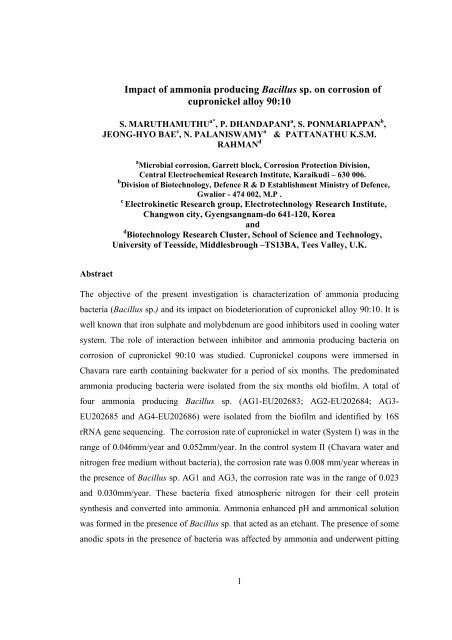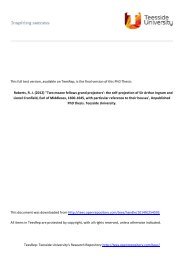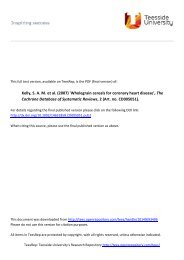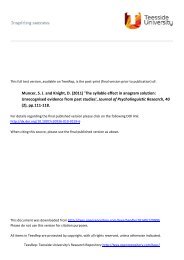Maruthamuthu, S. et al. - Teesside's Research Repository
Maruthamuthu, S. et al. - Teesside's Research Repository
Maruthamuthu, S. et al. - Teesside's Research Repository
Create successful ePaper yourself
Turn your PDF publications into a flip-book with our unique Google optimized e-Paper software.
Abstract<br />
Impact of ammonia producing Bacillus sp. on corrosion of<br />
cupronickel <strong>al</strong>loy 90:10<br />
S. MARUTHAMUTHU a* , P. DHANDAPANI a , S. PONMARIAPPAN b ,<br />
JEONG-HYO BAE c , N. PALANISWAMY a & PATTANATHU K.S.M.<br />
RAHMAN d<br />
a Microbi<strong>al</strong> corrosion, Garr<strong>et</strong>t block, Corrosion Protection Division,<br />
Centr<strong>al</strong> Electrochemic<strong>al</strong> <strong>Research</strong> Institute, Karaikudi – 630 006.<br />
b Division of Biotechnology, Defence R & D Establishment Ministry of Defence,<br />
Gw<strong>al</strong>ior - 474 002, M.P .<br />
c Electrokin<strong>et</strong>ic <strong>Research</strong> group, Electrotechnology <strong>Research</strong> Institute,<br />
Changwon city, Gyengsangnam-do 641-120, Korea<br />
and<br />
d Biotechnology <strong>Research</strong> Cluster, School of Science and Technology,<br />
University of Teesside, Middlesbrough –TS13BA, Tees V<strong>al</strong>ley, U.K.<br />
The objective of the present investigation is characterization of ammonia producing<br />
bacteria (Bacillus sp.) and its impact on biod<strong>et</strong>erioration of cupronickel <strong>al</strong>loy 90:10. It is<br />
well known that iron sulphate and molybdenum are good inhibitors used in cooling water<br />
system. The role of interaction b<strong>et</strong>ween inhibitor and ammonia producing bacteria on<br />
corrosion of cupronickel 90:10 was studied. Cupronickel coupons were immersed in<br />
Chavara rare earth containing backwater for a period of six months. The predominated<br />
ammonia producing bacteria were isolated from the six months old biofilm. A tot<strong>al</strong> of<br />
four ammonia producing Bacillus sp. (AG1-EU202683; AG2-EU202684; AG3-<br />
EU202685 and AG4-EU202686) were isolated from the biofilm and identified by 16S<br />
rRNA gene sequencing. The corrosion rate of cupronickel in water (System I) was in the<br />
range of 0.046mm/year and 0.052mm/year. In the control system II (Chavara water and<br />
nitrogen free medium without bacteria), the corrosion rate was 0.008 mm/year whereas in<br />
the presence of Bacillus sp. AG1 and AG3, the corrosion rate was in the range of 0.023<br />
and 0.030mm/year. These bacteria fixed atmospheric nitrogen for their cell protein<br />
synthesis and converted into ammonia. Ammonia enhanced pH and ammonic<strong>al</strong> solution<br />
was formed in the presence of Bacillus sp. that acted as an <strong>et</strong>chant. The presence of some<br />
anodic spots in the presence of bacteria was affected by ammonia and underwent pitting<br />
1





